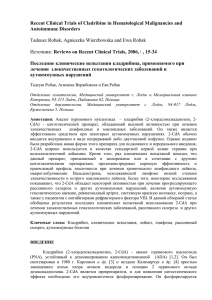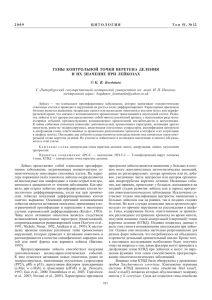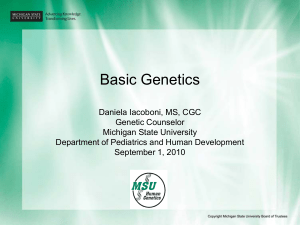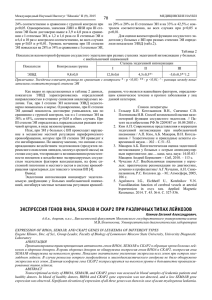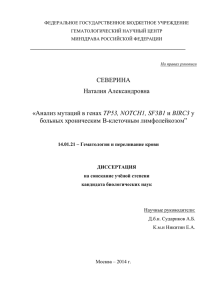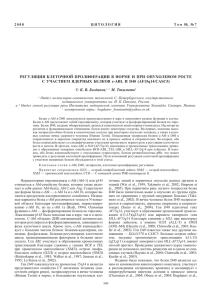CML-T1: A Cell Line Derived From T
advertisement

From www.bloodjournal.org by guest on April 27, 2016. For personal use only.
CML-T1:
A Cell
By Kazutaka
Most
Kuriyama,
data
chronic
stem
of B but
cell
not
line
CML
origin
with
the
CML-T1
have
analyses
and
ized by proliferation
their progenitors’2
from
the
events
region
chimeric
enhanced
a
tyrosine
persons
with
some
or more
of these
cases
have
absence
of
the
Ph
whether
T-cell
chromosome,9
rearrangement,’#{176}
and heterozygous
6-phosphate dehydrogenase
(G6PD)”
cells.
Also,
almost
B but
not
T cells.’2’5
However,
T-cell
all
other
of
T-cell-acute
reason
these
derive
with
inconsistent
CML.
Another
from
a progenitor
explain
Because of this
lished
a T-cell
prove
useful
typical
T cells
involved
describe
This
neutrophil-alkaline
splenomegaly.
Blood,
Vol
74.
low
Chromosome
From
No 4 (September),
1989:
T-cell
the
blood cells
with
to respond
mar
Cyto-
a T-cell
to treatment
pleural
the associated
invasion
by
effusion
pleural
karyotype.
blood
myeloperoxidase,
acetate
was
acid
esterase,
obtained
dur-
phosphatase,
and periodic
of these
Department
Rehovot,
is
Hematology
in
Los Angeles
that should
data were
cells.
female
with
granulo-
phosphatase,
of
and
spontaneously
of Hematology.
University
T
notion
of CML.
pp 138 1-1387
failed
peripheral
for
the Department
Nagasaki
to convincingly
in CML.
We estab-
analyses
consistent
+
cells
karyotype
was also normal.
extensive
),t(6;7)(q23;q34),
marrow
a 46,XX
of peripheral
were
from
Heparinized
Israel;
Cell
and
and
the
in
13-
acid Schiff
DHHS
RPG
and
by
Disease
Nagasaki
Weizmann
Department
Institute
of
Genetics,
Institute.
City.
Japan;
of Science.
Medicine.
Divisions
University
of
of
California
Los Angeles.
1 7. 1989;
part
Atomic
Medicine.
Biology,
ofMedicine.
January
Supported
of
Oncology
School
Submitted
USPHS.
Leukemia.
School
of
accepted
grants
May
CA23175
3. /989.
from
the
NC!.
NIH.
and by the Center
for
Advanced
Studies
is the Wald
Foundation
Scholar
in Biomedical
in
Communications.
Address
reprint
requests
Medicine.
Division
Medicine.
Los Angeles.
indicate
to Dr Robert
ofHematology
The publication
CA
This
article
in accordance
and
Peter
Gale,
Oncology,
Department
UCLA
of
School
of
90024-1678.
costs ofthis
payment.
“advertisement”
a
basophilia,
marked
del ( I I
cultures.
Stains
METHODS
was a 33-year-old
obtained
a-naphthyl
B cell involvement
studies
The patient
cytosis,
Cells
studies
from
Morphology.
charge
Case report.
underlying
of bone
(PHA)
patient
glucuronidase,
of hematopoiesis,
with CML
Preliminary
molecular
T
phase
regarding
findings
should
A diagnosis
of Phshe was treated
with
The WBC was 1 18 x
revealed
The karyotype
The
from
it is important
are
line from a person
in these
investigations.
we now
reported33;
the
controversy
whether
determine
and
again
months
CO2 atmosphere.
(ALL).32
progenitor.
ofT
that
CML-T1
ing the acute phase with the patients’
informed
consent.
Mononuclear cells were separated
by Ficoll-Conray
gradient
density
sedimentation,
washed twice, and suspended
in RPMI
1640 with 20%
fetal calf serum (FCS) and 10% dimethyl
sulfoxide
(DMSO).
The
cells were frozen and stored
in liquid
nitrogen.
Cells were thawed
at
the time of analysis,
washed
three times, and suspended
in Iscoves
minimum
essential
medium (IMEM)
supplemented
with 20% FCS,
100 U/mL
penicillin
0, and 100 g/mL
streptomycin.
Cells were
cultured
in plastic tissue culture
flasks at 37#{176}C
in humidified
5%
Ph-chromosome-
data
models
most
the disparity
as
2
a 47,XX,
22
(CFU-T)
acute
leukemia
a common
derived
T-lymphoid
infra).
with
in
possibility
is that myeloid
and B cells arise
cell distinct
from T cells. Transformation
could
cell
In
from
involve
consistent
Ph-chromosome
of lymphoid
contradictory
is unclear.
B cells
of this
lymphoblastic
for
involvement
cases
(vide
cells.
mes-
indicate
as that
Cytogenetics
immunologic
within
Cell
as well
phytohemagglutinin
phenotype
died
of the
Inc.
lymphoblasts
and
had
BCR
phase
or in T cells
cells#{176}28
as well
T
acute
the
and
are some
There
involving
positive
and
cultures
clonal
and
clearly
cells were normal.
CML was made, and
developed
3 years later.
marrow
with
chemical
typical
T cells are
involvement
of
findings
including
(CFU-GEEMT)’6”7
CML
The
report
T-cell
cells’8’9
ABL
stimulated
proto-
of Ph-chromo-
CML.
process
the Ph-chromosome.
without
ABL
on chromosome
cases
data
& Stratton,
of 90%
leukemia
expression
of glucosein chronic
phase
T
of lymphoid
studies
mitogen-stimulated
stem
cases
in CML,
involvement
pluripotent
transwith
CML.78
is considerable
controversy
in CML.
Evidence
against
include
and
These
Acute phase
with 79% lymphoblasts.
composed
cells
from
one half
Ph-chromosome,
in BCR
l09/L
cluster
of a
and
protein
Although
changes
busulfan.
insertion
to other
this
chromosome-negative
proto-
the breakpoint
22, transcription
bone
changes
of the
CML.
by Grune
dividing
Whelan,
molecular
in acute-phase
involved
in studying
1989
exhibit
ABI
similar
CML.
be
Kathy
9 to 22. rearrangement
of a chimeric
BCR-ABL
The
interstitial.
can
cells
transcription
(mRNA).
Klisak,
translocation
Ph-chromosome-negative
S
ABL
RNA
Ivana
chromosome
and
be useful
Underlying
of the
RNA
(mRNA),
BCR/ABL
kinase
activity.
CML
lack the
Ph-chromosome-positive
There
involved
gene.
Cytoge-
is character-
translocation.3
translocation
messenger
210-Kd
chimeric
gene.
cells
1 ). t(6;7)(q23;q24),
(CML)
chromosome
9 to
gne on chromosome
BCR/ABL
of
lation
of
1.21)
include
from
(BCR)
(TCRB)
from
of Chronic
Dreazen
including
some-negative
and
and accumulation
of myeloid
cells
and by the Ph-chromosome
resulting
t(9;22)(q34.l;ql
molecular
oncogene
leukemia
myelogenous
BCR
Yao,
CML-T1
CML.
oncogene
reactiv-
(MoAbs).
IV thymocytes.
del(1
of
appears
reactivity.
Eiichi
Phase
and Orna
karyotype.
of its T-lymphocyte
receptor
a 47.XX.
HRONIC
and
a T-lymphoid
antibodies
of type
+ mar
typical
hemato-
senger
cytochemical
indicate
in
in
Ikeda,
S. Sparkes.
Ph-chromosome-
with
Evidence
features
C
occurs
Acute
Shuichi
Robert
of myelopoiesis
a person
phase.
Tomonaga,
Ichimaru,
established
monoclonal
the
$-T-cell
of
cells
We
Masao
T-Lymphocyte
Leukemia
transformation
(CML)
progenitor
pattern
anti-T-cell
rearrangement
netic
is the
in acute
Gale,
Michito
malignant
) from
includes
ity
Peter
Yakir,
T lymphopoiesis.
(CML-T1
negative
Robert
leukemia
that
Derived
From
Myelogenous
Hadas
that
myelogenous
poietic
cell
suggest
Line
article
must
with
were defrayed
therefore
/8 U.S.C.
in part
be hereby
section
by page
marked
1 734 solely
to
this fact.
© 1 989 by Grune
& Stratton,
Inc.
0006-4971/89/7404-0025$3.00/0
1381
From www.bloodjournal.org by guest on April 27, 2016. For personal use only.
KURIYAMA
1382
(PAS)
were
scopic
studies
using
as reported.33
performed
of myeloperoxidase
electron
micro-
peroxidase
BCR
studies.
Surface
(slg)
lin (clg) were analyzed
by direct
cein isothiocyanate
(FITC)-labeled
and
immunofluorescence
goat
lyzed
immunoglobu-
using
F(ab’)2
fluores-
(Cappel
Laboratories,
antihuman
PA).
Cochranville,
provided
by Dr Y. Hinuma
(Kyoto
University,
immu-
1 . lmmunophenotypic
HLA-DR
(CD3)
The
T.
Mak,
two possible
provided
Ontario
junctions
Helper/inducer
T cells
OKT6
(CD 1 )
Cortical
T cells
OKT8
(CD8)
Suppressor/cytotoxic
OKT9
-
of 172 b of BCR
exons
“2”
and “3”
linked
Cells
Using
MoAbs
Percent
of Positive
thymic
8
T cells
43
or prolif-
56
cells and acti-
38
activated
receptor,
cells
(CD26)
Hematopoietic
precursor
vated lymphocytes
OKT11
(CD2)
Erosettereceptor
81
NK cells and LGL
Immature
99
T cells and most
mature
T
56
cells
NI(
0
cells and LGL
H-3 1 (CD25)
lnterleukin-2
GIN-14
HTLV-I
J5 (CD 10)
Common
B 1 (CD2O)
Pan-B
B2(CD21)
MatureBcells
B4 (CD 1 9)
B cells and pre-B
BA-i
(CD24)
B cells and mature
0KM
1 (CD 1 1)
Granulocytes
4. FMC
(IL-2)
receptor
0
0
ALL antigen
0
0
cells
0
0
cells
0
anuIocytes
0
and monocytes
Monocytes
1 7 (CD 14)
0
My 7 (CD 1 3)
Myeloid
cells and monocytes
0
My 9 (CD33)
Myeloid
cells and monocytes
0
FMC
Granulocytes
Megakaryocytes
11
1)
HPL 2 (CDw43
HPL 7 (CDw42)
Megakaryocytes
Erythroblasts
A
LGL.
large
0
and platelets
(gp 1 1 b/
0
and platelets
(gp 1b)
0
lIla)
Glycophorin
Abbreviations:
Cells
100
OKT1O
lb (CD16)
to 278 b of ABL
T cells
Transferrin
Leu-1
and
0
Leu-4
(CD7)
BCR
0
(CD4)
Leu-9
E.
100
OKT4
Leu-7
Dr
Research
between
(Ia)
erating
by
Cancer
cells
Mature
was ana-
rearrangement
(kindly
II.
Specificity
OKT3.
My
by Dr
provided
of the CML-T1
Analysis
Pan-T
(CD5)
probe
isowere
Institute
protection.
composed
Predominant
HLA-DR
Leu-1
cDNA
DNA
analyses
in CML
exon
Table
blot
are designated
L-6 and K562.39’#{176}
Probes complementary to these junctions
were synthesized
and radiolabeled
with 32P
using the riboprobe
system (Promega
Biotec, Madison,
WI). Radiolabeled probes were hybridized
to mRNA
from CML-Tl
followed
by RNase
digestion.39’#{176} mRNA
homologous
to a probe
forms
a
double-stranded
complex
and is thereby
protected
from RNase
digestion.
Protected
probes were analyzed
on urea-acrylamide
denaturing
gels. mRNA
from persons
in whom
the BCR breakpoint
occurs between
BCR exons “2” and “3” (L-6 junction)
protect a
280-b
probe composed
of 30 b of exon “2” linked to 250 b of ABL
exon II. mRNA
from persons
in whom the BCR break occurs
between
exons
“3”
and “4” (K562 junction)
protect a 450-b probe
performed.
of Differentiation)
(kindly
RNase
ABL
Japan).
is reactive
with the p19 antigen
of HTLV-I.
Immune
was also performed
on cells following culture for three
days
with
I % PHA. Terminal
deoxynucleotidyl
transferase
activity
(TdT; Bethesda
Research
Labs, Gaithersburg,
MD) was assayed by
indirect immunofluorescence.
Cytogenetics.
Cells were directly
processed
for cytogenetic
analyses by standard
and/or G-banding
methods.35
HTLV-1
analysis.
High mol wt DNA was isolated by standard
techniques.TM
Ten micrograms
were digested
with EcoR 1 , electrophoresed
in 0.7% agarose gel, and Southern
blotting performed
onto
nylon membranes.
Blots were hybridized
to a 1.2-kb 32P-labeled
HTLV-l
probe derived
from the 3’ end of the pol region and
(Clust&
(TCRB).
Southern
Institute).3738
phenotyping
Antibody
receptor
BCR
techniques.TM
BCR
Weizmann
to 870
GIN-l4
autoradiography
a 4-kb
and
of Science),
and a I .2-kb BCR intron
probe (Oncogene
Sciences,
Mineola,
NY).
Studies
of 13-T-cell
receptor
gene rearrangement
used a 770-b probe (Jurkat
cDNA)
spanning
the JH and CH regions
and corresponding
to nucleotides
100
Cells
Kyoto,
digestion,
by standard
using
Canaani,
stained
kindly
and f3-T-cell
endonuclease
performed
cytoplasmic
were
with the monoclonal
antibody
(MoAb)
indicated
followed
by
an FITC-labeled
F(ab’)2 antimouse
IgG. MoAbs used are shown in
Table I. HPL2 and HPL7
were kindly
provided
by Dr H. Shiku
(Nagasaki
University,
Nagasaki,
Japan).
H-31 and GIN-14
were
noglobulin
rearrangement
lation,
reactions,
were also performed.TM
diamino-benzidine,
Immune
Transmission
and platelet
ET AL
granular
lymphocyte;
HTLV-l,
human
T-cell
0
leukemia
virus
type
I; ALL,
acute
lymphoblastic
leukemia
antigen;
gp,
glycoprotein.
MoAbs
(Hialeah.
France)
were
purchased
from
FL) (J5, B 1 . 2. 4, My4,
(Glycophorin
A).
Becton-Dickinson
7 and 9). Hybritech
(Mountain
(La Jolla.
View,
CA) (Leu series
CA) (BA- 1 ). Sera-Labs
and HLA-DR).
(Adelaide.
Ortho
Australia)
(Raritan,
NJ) (OKT series
and 0KM
(FMC 1 1 and 1 7). and lmmunotech
1), Coulter
(Marseille.
From www.bloodjournal.org by guest on April 27, 2016. For personal use only.
T CELLS
IN CML
In situ
I .4-kb
hybridization.
v-abl
were
1383
probe
3H-labeled
cpm/zg)
One
of the
two
BCR
cDNA
probes
or a
and
provided
by Dr Owen Witte, UCLA)
by random
priming
(specific
activity
3 x 108
(kindly
and used for in situ hybridization
by standard
as modified
by Cannizaro
and Emanuel.42
Slides
seven days and silver grains overlaying
or touching
exposed
for
the chromosomes
esterase
PAS
was
and
Cell
the
media
vigorously
after
culture
ous
Cells
cultures.
of
1 month
by serial-cell
culture
for
were
changed
and
cultured
as described
with
weekly.
Cells
to
were
transfer.
maintained
CML-Tl
over
50 passages;
and
cytochemistry.
began
with
been
time
in continuis estimated
at 72 hours.
to
I 5 m
in
with
irregularity
granules
philic
with
clefts
and
are absent.
leukemia
antigen
(CALLA)(J5),
and
granular
lymphocytes
cytoplasm
indentations;
Electron
microscopy
azuro-
shows
nuclei
with
HTLV-/
HTLV-l
lamellar
tronic
complex.
except
for
microscopic
numerous,
cells are similar
Cultured
slightly
but there
is no
to acute-phase
del(
\
cells
It
$1
11
13
14
15
(data
and
analyzed
acute
from
showed
karyotype
1%
19
20
21
22
12
1%
18
1?
/
x
a.
fl
of the CML-Tl
cells showing
the 47.XX.
del(l
1 ). t(6;7).
(q23;q34),
not
+ mar
karyotype.
>100
marrow
All 36
47,XX,
1 ). An identi-
It
II
16
Os
Karyotype
a
(Fig
5
11
U
$2
.
of
studies
S.
10
and
CML-T1.
blood and bone
phase
were 46,XX.
CML-Tl
+ mar
ii
U
Fig 1
were
not shown).
Cytogenetic
on peripheral
chronic
NK
GIN-14
antibody
did not react
that the cells are not infected
blot
analysis
also
showed
no
in the cells
performed
cells
cells
similar
PHA.
K
9
7
was
phenotype
or with
were
(NK)
myeloid
killer
acute-phase
analysis.
H-31
and
activities
1 1 ),t(6;7)(q23;q34),
31
8
6
natural
4
IC II
activ-
lymphoblastic
(LAK)
3
2
‘I.
during
metaphases
and
acute
killer
suggesting
(1
(p
1.
cells
immu-
transferase
with
Southern
genomes
metaphases
detected.
cytoplasmic
(Leu-7),
were
The
cells,
HTLV-I.
were
cultured
analysis.
CML-Tl
ace-
OKT3,
common
immune
cells
fresh
Chromosome
maturity.
Light
and elecand platelet
peroxidase
increased
myeloperoxidase
K
some
detected
with
are
in
the
lymphokine-activated
was
moderately
clumped,
and
one or more
are present.
The Golgi apparatus
is well developed,
there are few lysosomal
granules.
Mitochondria
are large
Ribosomes
lobulations
The
or not
nucleoli
cells
or
nuclear
cytoplasmic
nonreactive.
whether
Chromatin
abundant.
indentations
and
I2
with
and
and
scanty
are
cells
and
a-naphthyl
esterase
Leu-7,
to B cells,
cells.
but
clefts
with
diameter
CML-Tl
I);
MoAbs
were
Morphology
I I (Table
negative.
large
were
on or in CML-Tl
cells. MoAbs
reactive
included
Leu-l,
7, and 9 and OKT4,
6, 8,
cells
and
activity
phosphatase
cells.
Surface
and
deoxynucleotidyl
studies.
CML-Tl
10,
9,
in continuous
has
doubling
one
grow
butyrate
in some
terminal
not detected
acid
fl-glucuronidase,
a-naphthyl
and
were
ity
for
detected
Immunologic
esterase
for
positivity
positivity
also
noglobulin
RESULTS
chloroacetate
dot
dot
tate
scored.
half
AS-D
Intense
moderate
techniques4’
were
a-naphthol
absent.
From www.bloodjournal.org by guest on April 27, 2016. For personal use only.
KURIYAMA
1384
AB
cal karyotype
was
pleural
Direct
fluid.
acute
phase
was
detected in leukemia
analysis
not
Rearrangement
sis of
CML-Tl
to the
TCRB
2.8
Kd
also
detected.
were
used
probe
positive
.
22;
CML
ofa
of
BCR/ABL
Chromosome
labeling
j4.4
represent
the
respectively.
4
.
situ
of chromosome
mosome
9 (Fig
hybridized
digestion
Having
some
ABL
the
BglII
RNase
without
that
ABL
alleles,
probe
showed
grains
over
chro-
BamH
(Fig 4).
and EcoR 1
Similar
data
I
HindIII
(data
not shown).
is translocated
to chromo-
and
ABL
BCR
is
rearranged,
we
investigated
of the chimeric
in transcription
typical
of Ph-chromosome-positive
a break
indicates
excess
in situ
9 (Fig 3A, B).
presumably
BCR
probes.
bands
protection
assay.
the 280-b
L-6 probe
protected
Extensive
was studied
by Southern
blotting
with restriction
endonucleases
that
resulted
this
mRNA
This
of BCR
digested
with
and
22
by
D).
determined
whether
studied
scored:
translocated
with
to both
BCR
rearranged
revealed
obtained
were
was
were
and
22
3C,
DNA
CML-Tl
and
Fig 2.
Rearrangement
of
TCRB gene in CML Ti . Lane A.
placental
DNA;
B. CML
Ti.
DNAs
were
digested
with
BamHl
and hybridized
to a 770b H and C,, TCRB probe.
ABL
hybridization
labeling
of
2.8
of
metaphases
untranslocated
In
criteria
3) transcription
on chromosomes
22 and
long arms of these chromosomes
Rearrangement
‘#{248}-
and
detected
on the
were
mRNA.
localization
was
Kd
Three
rearrangement;
Fifty
Labeling
of 4 Kd and
4.4
typical
Ph-chromosome
of ABL to chromosome
with
) translocation
I
BCR
analy-
hybridized
bands
rearrangement.
chimeric
hybridization.
from
from
blot
and
of 12, 9, and
CML-TI
cells:
BamHl
novel
bands
genetic
evidence
2)
with
indicated
Germline
to compare
Southern
receptor.
digested
cDNA
CML-related
I2
T-cell
DNA
2).
obtained
blood cells
performed.
of
(Fig
cells
of peripheral
ET AL
BCR/
CML
mRNA
from
CML-TI
but not the 450-b
K562
between
BCR
exons
“2”
in
cells
probe.
and
“3”
and
B
5
IC
5
r(I)
z
‘5
a:
1
q
p
I
2
q
p
3
q
Ip
4
c
p
I
5
q
5
IC
5
_____________________
L’J
p1
q
I
p
q
Ip1q
_________________
Ip
p
P’q
I
q Ip’q
6
2
5
IC
5
--
Ip’ q p q p q p’ q
13
14
IS
IC
III
p q
q 1pIqT1qIpF1
7
C HROMOSO
18
9
2C
21
22
X
mar
MES
Fig 3.
In situ hybridation
of CML-Tl
to ABL and BCR probes.
Panels A and B show cytogenetics
and histogram
of grain counts with
ABI probe; panels C and D show similar studies with a BCR probe. Arrows
indicate
labeled chromosomes
22. Sometimes
it was difficult
distinguish
chromosome
22 from the mar chromosome.
In this analysis
grains were assigned
to the former.
an
to
From www.bloodjournal.org by guest on April 27, 2016. For personal use only.
T CELLS
1385
IN CML
15
D’#{176}
5
-;
U)
z
q
2
#{149}
q
#{149}
‘p
P
15
‘
q‘
15
4
10
0
5’
w
.iIi
.
‘i
I
I.
Ip’q
p’6q
l..
ii
I
p1q
z
J
q
i
p’q
Jp’q
20
15
1O
5
.
‘.
I
pq
‘.‘
p
13
....
I
qlp
14
‘‘.
I
I I
I
qpqpqpqpqpqpqpqp
15
16
.11111
.
q
17
18
19
20
21 22
X
CHROMOSOMES
Fig
Fig 3C.
transcription
Western
AB
both
ofa
analyses
anti-BCR
3D.
chimeric
and
mRNA
protein
BCR/ABL
showed
a 2I0-Kd
anti-ABL
antisera
(data
(Fig 5).
reactive
Also,
with
not shown).
AB
DISCUSSION
This
study
CML-Tl
associated
ofCML-TI
studies
Immunologic
,
T-cell
absence
t
deals
with
is a T cell and analysis
with the BCR and ABL
phenotype
of staining
of
two issues:
of the
genes.
CML-Tl
characterized
CALLA,
TdT,
evidence
molecular
revealed
that
events
a stage
IV
by Leu-l
reactivity
and
and HLA-DR.43
Reactiv-
-J
0
0
Fig 5.
say with
CML
BamHl
EcoRl
Fig 4.
BCR rearrangement
demonstrated
by Southern
blot
analysis.
DNA extracted
from CML Ti cells (A) or normal
lymphocytes (B) was digested
with BamHi
or EcoRl
and analyzed
with a
1 .2-kb intronic BCR probe (left panel) or with EcoRi
and hybridized
to a 4-kb
BCR cDNA
probe
(right
panel).
Arrows
indicate
the
rearranged
bands in CML Ti DNA.
Ti
RNAse
CML-Ti.
and
protection
mRNAs
KCL
asfrom
(a Phchromosome-positive
CML cell
line) protect
a 280-b
chimeric
probe
from
RNAse
digestion.
The two
normal
ABL mRNAs
protect
fragments
of 250 b and
255 b. The 280-b
1-6 probe is
protected
only
by BCR/ABL
mRNA
in which
BCR exon “2”
is spliced to ABI exon II.
28O-
22
255
250
I
I
From www.bloodjournal.org by guest on April 27, 2016. For personal use only.
1386
ity
KURIVAMA
with
4, 6, 8, and
OKT3,
stage
T-cell
of
positivity
for
consistent
with
acid
of
ofa
are
typical
from
than
reciprocal
translocation
similar
acute
cells.
analyses
phase
Direct
were
performed.
Leukemia
showed
a 47,XX,
These
ofcells
this
to
the
CML-Tl
gene48
and
the
fluid
and
MYB
chronic
proto-oncogene.49
not
CML-T1
karyotype.
from
the
occurred
the
with
be relatively
studied
and
ABL
and
by
cells
In either
by
T
cells
have
rather
than
useful
to study
this
progenitor.
not
of
This
breakpoints
were
BCR
Unfortunately,
unavailable
clearly
could
within
respectively.
indicate
prove useful
for
the
in studying
become
interstitial
involves
reciprocal
involved
insertion
translocation,
this
Dr Emanuel
involvement
are
phase
analysis.
of
possibility
the
mechanism
in CML.
ofABL
this
cell
line
Since
in
into BCR
may also be
process.
ACKNOWLEDGMENT
T 13-receptor
Perhaps
T cells
acute
T cells
patient
may
is reported.28
typical
of
of the
indicated,
lymphoid
in CML.
should
which
into
situation
as
in a T-cell
data
involvement
CML-Tl
been
our
our
of developing
cells. This
or
genomic
and
from
possible
Transformation
capable
myeloid
T
typical
is that of two distinct
transformcell common
to B lymphocytes
and
a second
event,
are
ABL
several
with
cell
since,
analyzing
in myeloid
myeloid
those
cells
and
in CML.
chronic
in a stem
one
CML-Tl
cytogenetic
rare,
possibility
cells
recombinatorial
CML-T1
consistent
and
in
Another
events,
pheno-
investigate
of BCR
in a stem
involved
be
are
B lymphocytes
myeloid
translocation
to
that
involvement
occurred
must
T-cell
the
results
well
CML.
T-cell
normal
Studies
rearrangement
of T-cell
have
of
gene.
our data indicate
T as
ing
because
the
this
in progress.
These
CML.
influenced
Alternatively,
TCRB
molecular
frequency
may
different
site
were
+mar
marrow
of
map
of
derived
of transformation
translocation
proposed
Ph-
blood
cells
Alternatively
finding
sites
the
from
of blood
a subclone
t(6;7)(q23;34)
involves
have
are
have
cells.
within
typically
absence
PHA-stimulated
in the bone
The
in diverse
Interestingly,
cells
pleural
clone.
karyotype
detect.
abnormalities
leukemia
mechanisms
This
with
with
1) t(6;7)(q23;q34),
represent
of
no
ABL.
persons
marrow
from
acute-phase
and
low
too
of
as were
cells
may
marrow
the
In summary,
cells
might
showed
and
consistent
analyses
del(l
findings
bone
normal,
(unstimulated)
probe
BCR
studies
of bone
expres-
findings
CML.’47
between
prior
22,
might
T 13-receptor
of
events
chromosome
9, consistent
into chromosome
22 rather
to
CML7
and
in this case.
Ph-chromosome
and
I might
to
and
These
a BCR
of ABL
to
chromosome-negative
Cytogenetic
is also
of
9
mRNA,
protein.
with
translocation
insertion
the
the
ty pe
rearrangement
Ph-chromosome-positive
analyses
interstitial
is
of
dot
gene
chromosome
BCR-ABL
with
finding
from
BCR-ABL
chimeric
its
f3-glucuronidase
indicated
ABL
a chimeric
of cells
of
in this
intense
as is T 3-receptor
ofCML-Tl
In situ hybridization
evidence
and
of
possibilities
of
210-Kd
sion
is variable
finding
development,”
translocation
transcription
Leu-7
The
phosphatase
T-cell
rearrangement.45
Molecular
studies
BCR,
1 1 and
development.
ET AL
typed
was
Maidenberg
by Kirsten
helped
to prepare
the manuscript,
which
Laage.
REFERENCES
Koefiuer
HP, Golde DW: Chronic
myelogenous
leukemiaN EngI J Med 304:1201,
1981
2. Champlin
RE, Golde DW: Chronic
myelogenous
leukemia:
Recent advances.
Blood 65:1039,
1985
3. Rowley
JD: Chromosome
abnormalities
in human
leukemia.
I.
new
chromosome-positive
concepts.
Ann
Rev Genet
4.
A,
oncogene
adjacent
Bartram
leukemia.
of abl and
315:550,
Grosveld
G:
to a translocation
Groffen
bcr genes
J, Hanesen
in chronic
of
Localization
breakpoint
in
PF,
c-abl
the
chronic
myelo-
JB,
c-abl
in
E: Fused
leukemia.
tranNature
K562
Witte
ON:
An alteration
cells
unmasks
leukemia
of the
associated
kinase activity.
Cell 37:1035,
1984
Dreazen
0, Klisak I, Fey R, Goldman
JM, Sparkes
RS, Gale
Do oncogenes
determine
clinical
features
in chronic
myeloid
RP:
leukaemia?
8.
Lancet
JA,
Young
JM:
Goldman
1:1402, 1987
TS, Rasool
Ganesan
Hibbin
chromosome
BD,
F, Guo
White
A-P,
H,
Rearrangement
negative
of the
chronic
Th’ng
KH,
Kumarau
myeloid
bcr
TO,
gene
leukemia.
Dowding
Gallon
C,
DAG,
in Philadelphia
Blood
68:957,
Kearney
cytogenetics
10.
Durrang
L,
Orchard
in chronic
Bartram
P: T lymphocytes
CR,
KH,
granulocytic
Raghavachar
lack rearrangement
Hibbin
J,
Goldman
leukemia.
Lancet
A, Anger
B, Stain
of the
bcr gene
JM:
1:858,
J Clin
leukemia.
Blood
62:815,
MF,
69:1682,
Revesz
Ritz
5,
Pesando
JM
LeBien
14.
chronic
TW,
myelocytic
Engl J Med
cell target. Leuk
16. Mirand
tional
leukemia
in a precursor
Cancer
myelogenous
Congress:
CML.
lymphoid
and
J,
Lazarust
acute
H,
lympho-
1980
J. Origin
J, Kersey
of pre
of
B lymphocytes.
BR, Hoffbrand
N
AV, Drysdale
I: Pre B phenotypes
Evidence
AA,
leukemia.
agar
Kanz
arise
WB,
in blast
stem
for a pluripotent
Mihich
Proceedings
September
Nogueira-Costa
rosette-positive
of
Res 3:181, 1979
B cells
1982
18.
positive
Congress.
Fauser
M,
1979
EA, Hutchinson
Cancer
Roberts
crisis of chronic
to human
283:583,
J, Minowada
in Philadelphia
TA,
Blast
McConarty
antibody
1 5. Greaves
MF, Verbi W, Reeves
HC, Jones J, Sacker LS, Samaratunga
crisis
from
analysis
Hozier
301:144,
NM:
1976
Notis,
SF: A monoclonal
leukemia
antigen.
Nature
Schlossman
Lowenthal
lymphocytes
P, Kister
MEJ:
marker
34:179,
some
1978
D, Beard
surface
Ri,
of
Invest
G, Katovesky
Cell
Jacobson
Origin
G, Greaves
leukemia:
probably
in Philadelphia
AM,
leukemia:
cases. Br J Hematol
T-cell
C, Bettelheim
myelocytic
Denman
cells.
J, Kirk
myeloid
17.
I 986
9.
stem
blastic
tyrosine
7.
leukemic
1 3.
Canaani
myelogenous
SM,
Watanabe
protein
myeloctyic
myeloid
1985
6. Konopka
human
JR,
Nature
306:239,
1983
E, Lifshitz
B, Gale RP,
5. Shtivelman
script
CR,
PJ,
Chronic
I 2. Janossy
Stephenson
N,
de Klein
cytic
1 1 . Fialkow
14:17, 1980
Heisterkamp
chronic
I987
8- 1 5, 1982,
L,
Bross
from
J Clin
the
Invest
R, Spitzer
colonies
E (eds):
of
the
1 3th
Lohr
GW:
75:1080,
Cork
the
T
clone
malignant
containing
International
Seattle.
KJ,
G,
13th Interna-
cells
in
and
chronic
1985
A,
Trujillo
Philadelphia
JM:
chromo-
E
From www.bloodjournal.org by guest on April 27, 2016. For personal use only.
T CELLS
IN CML
some
chronic
in
1387
myeloid
Scand
leukaemia.
34:184,
J Haematol
Soda
33.
Yoshida
1985
R, Spitzer
Nogueira-Costa
I 9.
in benign
phase
chronic
G, Khorana
myelogenous
5: T-ceIl
leukemia.
Res
59:671,
Griffin
JD,
EL, Sherwood
1-cell
R, Canellos
surface
antigens
RP, Daley
Megakaryoblastic
in
a patient
with
demonstration
blast
crisis
of
chronic
leukaemia
Laboratory
exhibiting
features
characteristic
of early
I blasts.
J Haematol
32:41 1, 1984
22. Jacobs P. Greaves M: Ph-positive
I lymphoblastic
transformation. Leuk Res 8:737, 1984
23. Ohyashiki
K, Oshimura
M, Uchida
H, Shirota
1, Sakai
N,
Hiramine
N, Okawa
H, Sasaki
R, Tonomura
A, Ito H: Characterization
of extramedullary
myelogenous
tumors
leukemia:
phocytes.
Cancer
Genet
24. Allouche
M,
Salvatore
A,
lymphoid
blast
in
Possible
Cytogenet
H,
crisis
A,
Jasmin
of
of
Ph-positive
C: I
chronic
cell
myeloid
V,
lineage
leukemia.
gene
and
LC, Furley
rearrangement
involvement
ofCGL.
26.
Blood
blast
AJ,
of the
1W:
having
145,
312:521,
39.
Greaves
cluster
region
in blast
1
PG:
1-cell
-positive
62:776,
receptor
chronic
myeloid
B
with
rearrangement
leukaemia
not of the I cell
28.
K,
Hato
Kobayashi
Y:
myelogenous
29.
B chain
M,
Yasukawa
Takada
mixed
receptor
1,
Shiosaka
with
H,
Dankbaar
Kawamure
Tamai
and
Br J Haematol
Philadelphia
T,
Phenotypic
leukaemia
crisis.
K,
region
Blood 69:1082,
genes.
Iwamasa
cluster
1,
5,
Fukuoka
genotypic
1,
1987
R, Spaander
chromosome
positive
T-ALL.
Br J Haematol
of G-banded
83:431,
Nathan
with
DG,
late
56:139,
BA,
MM,
Tantrauahi
developing
Nell
R: 1-cell
M,
acute
Philadelphia
Lipton
JM,
by multiple
JPM:
chromosome.
Br
A, Criel
A, Verfaillie
leukemia.
Cancer
CM:
Genet
SE,
46.
genes
48.
Philadelphia-positive
chain
16:297,
Canaani
E:
abl gene
human
1986
ofsingle
by in situ
situ
copy
DNA
hybridization.
Improved
Chro-
methods
hybridization.
for
G
Cell
Cytogenet
MD,
0,
N,
are
1W:
and
AppI
The
structure
1983,
Scm
M,
Saxe
on chromosome
I
cell
25:74,
antigen
68:327,
Molecular
leu1979
1986
biology
of
1988
A model
for human
1988
D: The
I-cell
6 in mice
and
receptor
beta
chromosome
7
in humans.
1985
32.
delphia
Roozendaal
chromosome
characteristics.
KJ, Van der Reijden
positive
acute
Br J Haematol
HJ, Geraedts
lymphoblastic
47:145,
1981
JPM:
leukemia
Philawith
49.
I
Cell 37:1091,
1984
Bboomfield
CD, Irent JM,
Blood
leukemia:
1:809,
and
23:255,
of the
Hematol
myelogenous
Haematol
Histochem
RP:
R,
Modern
p 348
of normal
I cells.
E, Gale
A
as
K (eds):
Springer,
Basic
RC:
in Neth
Winkler
malignant
Kronenberg
located
differentiation
C: Cytochemistry
leukemia.
Clin
Nakazawa
cell
MAS,
V. Berlin,
Canaani
Chronic
I,
A, Gallo
at leukemia-lymphomas,
Moore
Mak
in normal
E, Sugimoto
I, Frankel
hematopoietic
A review.
RP:
Cacoia
K, Tatsumi
Leukemia
Baillaire’s
genes
BA,
the
47:277,
I, Miyoshi
markers
myelogenous
47. Gale
J Haematol
Roe
from
BS:
in
D, Costello
Dreazen
chronic
leukaemia
Cytogenet
308:
1987
RP,
Localization
Emanuel
human
lymphocytes:
cancer.
lymphoblastic
Nature
Berrebi
A, Zaizov R,
RNA in patients
with
69:971,
Cell
GF:
after
MF,
in Human
45. Minden
50:543,
lymphoblastic
for
Catovsky
kaemic
gene.
Kubonishi
Greaves
RC,
0,
transcribed
J, Minato
I,
scheme
Trends
Sallan
I,
a protein
1984
Gallo
1984
3 1 . Louwagie
1-acute
Reid
LA,
Minowada
receptor
Miller
Alexander
encodes
chains.
E: bcr-abl
chromosomes
chromosomes
determined
I982
30.
A
Spring
1981
Cannizzaro
38:308,
Dreazen
Blood
Saunders
5,
chronic
Geraedts
fused
ME,
Harper
Ohnuma
44.
PJ,
Cold
SP,
clone
B, Gale
of RNAs
model
66:331,
Willemze
K, Clark
cDNA
RP,
leukemia.
5,
and megakaryoblastic
I lymphoblastic
43.
5,
Fujita
of
chromo-
Cloning.
York,
to immunoglobulin
E, Lifshitz
the bcr-abl
from
Genet
but
1987
analysis
New
Y, Leggett
I, Canaani
splicing
banding
Murakami
Harbor,
cell-specific
E, Gale
Shtivelman
42.
breakpoint
J: Molecular
Sanbrook
Spring
homology
I, Miyoshi
mosoma
1986
of the
1978
for human
1984
sequences
gene
Gramatzki
M, Bartram
CR, Muller D, Walter M, Tittelbach
H, Kalden
JR: Early I cell differentiated
chronic
myeloid
leukemia
crisis
51:45,
technique
NC:
ultrastructural
Y, Antoniou
D, Clark SP, Yanagi
Y, Sangster
R,
P, Ierhosrst
C, Mak TW: Sequence
and expression
of
of the human
I-cell
receptor
B-chain
genes. Nature
Alternative
and
27.
blast
I
myelogenous
40.
crisis
B-chain
A, Gorin
by the
1982
A human
Kubonishi
receptor
G, Najman
Blood
banding
EF,
Cold
Shtivelman
41.
of Ph
J Haematol
Br
breakpoint
of the T cell
Philadelphia
Br J Haematol
Yoshikai
in
DA,
J, Duhamel
peroxidase.
Y, Yoshikai
extensive
involvement
Yardumian
expression
A, Pelicci
in a case
crisis.
AM,
with
leukaemia.
Lym-
1984
R,
1986
B, Tabilio
Falini
Ford
and
67:533,
rearrangement
cell
Mak
chronic
Chan
M F: Clonal
I,
M:
a patient
Identification
1, Gritsch
Laboratory,
Cousolini
1985
25
E, Amenomori
Ichimaru
1971
Manual.
Yanagi
37.
38.
66:1155,
Yao
N,
Van den Elsen
T lym-
Blood
J, Reyes
2:971,
transcripts
Georgoulias
in
myeloid
M: A rapid
Maniatis
Harbor
chronic
of immature
1 5:1 1 9, 1985
Bourinbaiar
Auclair
a case
involvement
phenotypes
chronic
of platelet
Lancet
36.
Scand
M,
I, Sadamori
leukemia:
Seabright
35.
Blood
I-cell
Breton-Gorius
somes.
leukemia.
Jinnai
1985
34.
61:640, 1983
21 . Herrmann
F, Komischke
B, Kolecki P, Ludwig WD, Sieber
G, Teichmann
H, RflhI H: Ph’ positive blast crisis ofchronic
myeloid
myeloid
K, Tomonaga
I,
negative
GP, Wisch JS, Reinherz
JF, Lane H, Schlossman
SF:
Tantravahi
0, Beveridge
with
chromosome
10:1433,
I 986
20.
Matsuo
crisis
phoid
involvement
Leuk
H, Kuriyama
Y,
committee
gene
mapping
on structural
9. Cytogenet
van den Berghe
chromosome
Cell
changes
Genet
46:344,
H: Report
in neoplasia.
1987
of the
Human
From www.bloodjournal.org by guest on April 27, 2016. For personal use only.
1989 74: 1381-1387
CML-T1: a cell line derived from T-lymphocyte acute phase of chronic
myelogenous leukemia
K Kuriyama, RP Gale, M Tomonaga, S Ikeda, E Yao, I Klisak, K Whelan, H Yakir, M Ichimaru and RS
Sparkes
Updated information and services can be found at:
http://www.bloodjournal.org/content/74/4/1381.full.html
Articles on similar topics can be found in the following Blood collections
Information about reproducing this article in parts or in its entirety may be found online at:
http://www.bloodjournal.org/site/misc/rights.xhtml#repub_requests
Information about ordering reprints may be found online at:
http://www.bloodjournal.org/site/misc/rights.xhtml#reprints
Information about subscriptions and ASH membership may be found online at:
http://www.bloodjournal.org/site/subscriptions/index.xhtml
Blood (print ISSN 0006-4971, online ISSN 1528-0020), is published weekly by the American Society of
Hematology, 2021 L St, NW, Suite 900, Washington DC 20036.
Copyright 2011 by The American Society of Hematology; all rights reserved.
